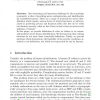Free Online Productivity Tools
i2Speak
i2Symbol
i2OCR
iTex2Img
iWeb2Print
iWeb2Shot
i2Type
iPdf2Split
iPdf2Merge
i2Bopomofo
i2Arabic
i2Style
i2Image
i2PDF
iLatex2Rtf
Sci2ools
ASIACRYPT
2001
Springer
2001
Springer
Secure Human Identification Protocols
One interesting and important challenge for the cryptologic community is that of providing secure authentication and identification for unassisted humans. There are a range of protocols for secure identification which require various forms of trusted hardware or software, aimed at protecting privacy and financial assets. But how do we verify our identity, securely, when we don't have or don't trust our smart card, palmtop, or laptop? In this paper, we provide definitions of what we believe to be reasonable goals for secure human identification. We demonstrate that existing solutions do not meet these reasonable definitions. Finally, we provide solutions which demonstrate the feasibility of the security conditions attached to our definitions, but which are impractical for use by humans.
ASIACRYPT 2001 | Cryptology | Secure Authentication | Secure Human Identification | Secure Identification |
| Added | 23 Aug 2010 |
| Updated | 23 Aug 2010 |
| Type | Conference |
| Year | 2001 |
| Where | ASIACRYPT |
| Authors | Nicholas J. Hopper, Manuel Blum |
Comments (0)

